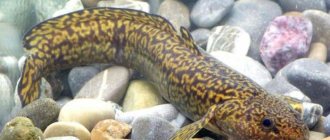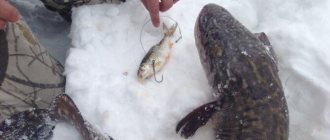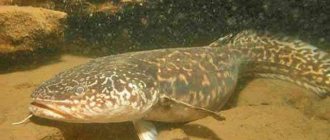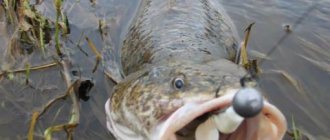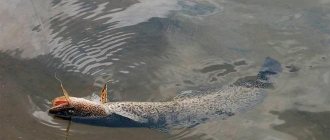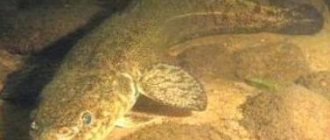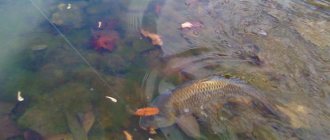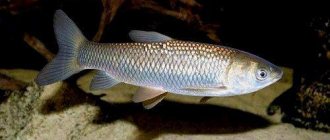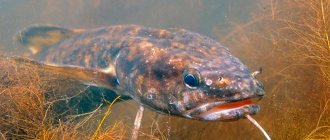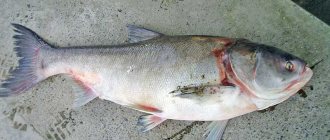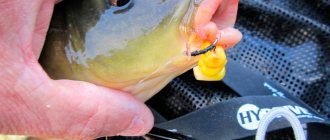The liver is like a fishing bait
Buy quality products at affordable prices in the best fishing online stores
. Give gifts to yourself and your loved ones!
we are in social networks
— follow us on , , and Instagram. Stay up to date with the latest site news.
Fishermen who catch catfish and chub often use chicken and beef liver as bait. It has a number of positive properties. Liver itself is a very nutritious product. Getting to the bottom, it secretes juices that create a fragrant trail. The fish senses the smell and quickly finds tasty food.
Another advantage of the liver is that it is a soft bait that the fish can easily swallow and digest. Only fresh liver is suitable for fishing. In this article we will learn how to put a liver on a hook, how it is stored when fishing, and what equipment is used when fishing for chub and catfish.
How to put a liver on a hook
Since the liver is a fairly soft bait, it can easily fly off the hook. Often the fish manages to easily pull it off the hook. There are several ways to avoid such annoying losses.
In the first case, a small piece of women's stockings is cut off and a bag is made from it. We place the liver in this bag and tie it with a thread. This bait is used on carp and hair rigs. Or you can simply hang it on a hook, as shown in the picture. The result is a fairly voluminous bait that the small fish cannot knock off the hook. In general, it turns out that the hook seems to be buried in the nozzle. This method of baiting is designed so that the fish will swallow the bait. Yes, bites will be rare, but only large fish will bite.
Another successful way to attach the liver is to tie it with a thread. You probably won't be able to do it the first time. But with a little practice, you can learn this simple task. A simpler option using rubber bands. With their help, pellets are attached to the hook. Only in our case it is necessary to use slightly larger elastic bands. You can take children's elastic bands, which are used for weaving various crafts. They look like this.
Another option is to attach the liver to a size 8 tee. The liver is threaded onto each hook and a reliable fixation is obtained. In this case, it doesn’t even matter how hard the liver is. We insert it so that the stings completely come out of the pulp.
How to catch chub with liver
When fishing for chub, a rod up to 3 meters long is used. A section of the river with a fast current and whirlpools is selected. The rig is thrown downstream. We fish with one fishing rod, as we often have to change our fishing spot. Fishing for the liver of a chub does not require the fisherman to stay in one place. This is mobile fishing.
It is better to hold the fishing rod in your hands, as its bites are very greedy and often the rod can end up in the water without supervision. What equipment is suitable for chub fishing? Most often, a fishing line with a thickness of 0.3 mm is used, on which a sliding weight runs. A leash with a diameter of 0.25 with a hook on a long fore-end No. 6-8 is attached to the end.
If it is a tee, then No. 8, and if it is a single, then No. 6.
The weight of the sinker is selected based on the strength of the current. Typically it varies from 40 to 80 grams. It is necessary that it moves slightly downstream. The length of the leash, as we see, is quite large, approximately 60-70 cm. This is the optimum that will allow you to feed the bait as naturally as possible and make it moveable under the influence of the current. Moving bait provokes the chub to bite.
Usually chub fishing looks like this. The equipment is thrown to a promising point. This could be an area with a rip current, where the water churns or the current changes direction slightly. We cast it and wait 5-10 minutes for a bite. If it is not there, we throw it at another point: under a snag or on a hole, and again wait a little. We fish a place for 30-40 minutes and move to another if there are no bites.
If a large chub bites, then after fishing there is a pause of 15-20 minutes. Under no circumstances should you change your location. Chubs prefer to sit in the same places. You just have to wait out this time and you can again count on biting and catching fish.
How to catch catfish with liver
One of the best baits for catfish is chicken liver. Beef is also used, but it is still inferior in catchability to chicken. The middle pieces are placed on the hook. The result is a volumetric nozzle of this type:
Another interesting option for planting liver is to grind it in a blender and mix it with flour. The result will be a red dough. Take a ball the size of a fist and place it on a tee of the appropriate size. We catch catfish with a bottom fishing rod and a boat or a hook with a nylon rope.
How to preserve your liver while fishing
When fishing, the liver can be placed in a container with an open lid and placed in the shade. If you have a portable small refrigerator or thermal bag, it is better to store the nozzle in it. Ice cubes also help. They are placed in a container, and a bag of liver is placed on top.
It is important to always remember that direct sunlight has a negative effect on the liver. In the sun it becomes jelly-like and then impossible to put on a hook.
Details about other unusual attachments:
Good fishing online stores
will allow you to purchase any fishing goods at competitive prices!
Follow us on social networks
— through them we publish a lot of interesting information, photos and videos.
Popular sections of the site:
The fisherman's calendar will allow you to understand how all the fish bite depending on the time of year and month.
The best baits for burbot
09.10.2019
Among cod fish, burbot is the only species that lives in fresh water. The unique taste of this fish provokes many fishermen to hunt for it. Burbot liver, which has many useful qualities, is considered a real delicacy. Not every water resource in our country is ready to please with the presence of burbot. But even in its habitats, it is quite difficult to catch it without the right bait. The best bait for burbot will be pleased with the positive result; it is up to the fisherman to choose it.
Features of choosing bait for burbot
At one time, burbot prefers live bait, at another - pieces of dead fish. The main rule for choosing a bait when fishing is to study the reservoir. If a large number of crayfish are present, the fish considers them a delicacy. You will understand what kind of bait burbot bites on if you study the characteristics of the reservoir. Fish prefer food that is abundant in a particular place. Given this feature, it is easy for an angler to choose the best bait for a particular situation.
Regardless of what bait you use to catch burbot, make sure it is fresh. The recommended length of the nozzle is from 7 to 15 centimeters. The use of large bait is explained by the presence of a large mouth. Choose the appropriate nozzle. Worms and crawlers are planted in large bunches. The predator will not notice single specimens. The color of the bait does not matter when catching burbot. He does not have sharp eyesight. However, an excellent sense of smell allows you to smell the bait from a great distance.
Natural bait must be fresh
Baits for burbot fishing
Predatory fish prefer baits of animal origin. It is difficult to understand what kind of bait burbot likes in a particular body of water.
It is recommended to try all baits. The most popular of them:
- worms Red dung worms, placed on a hook in the amount of 7–10 pieces, are suitable;
- shrimp. The fish is attracted to raw shrimp, but under certain circumstances it prefers cooked bait;
- cancer. It cannot be considered a favorite food. But if there are a lot of crayfish in the reservoir, the burbot has to get used to such food;
- larvae of various insects. Large numbers of large larvae are attached to the hook. They create a bunch that attracts fish with their smell;
- leeches. When fishing for burbot, choose large and juicy leeches;
- Chicken or goose liver is used. When catching a predator, use any chicken giblets;
- crawls out like a leech - the more the better;
- frogs. Use juveniles. They attract the attention of the fish as much as possible;
- live bait Gobies, minnows, and ruffs are suitable here. The fish is hooked behind its back;
- dead fish. Cut pieces of suitable sizes attract inactive fish due to their accessibility.
Color in baits for burbot is not the main thing
In addition to the main baits for burbot, lard also often produces positive results. Burbot is often caught by spinners hunting for perch or pike perch. But this applies to random bites, because burbot is not considered an object for fishing with a spinning rod. The time of year plays an important role when choosing bait for a predator.
Lures that attract fish in the summer are often ineffective in cold weather. Its changes affect the decrease or increase in the activity of living organisms that serve as food for fish.
Autumn baits
In the fall, burbot baits should have high nutritional value. It is recommended to use a variety of protein-rich baits. Experienced fishermen resort to a trick - they put a large bunch of crawlers on the hook. It minimizes the bite of small fish. But if one bites, it will automatically become a live bait.
Winter attachments
Unlike other fish species, with the onset of cold weather, burbot becomes more active. The activation of the predator forces anglers to use the same active baits. Live bait is the best bait for burbot in winter. Make sure he remains alive and active. The burbot senses all its vibrations at a great distance.
https://www.youtube.com/watch?v=rg5JEsEwTTg
The amount of bait depends on its size
Spring tips
It is generally accepted that in the spring, most burbot individuals prefer frogs. But in bodies of water where they are considered natural inhabitants. In other bodies of water, the best bait for burbot is selected through experimentation.
Summer tips
In the summer, the predator does not please with its activity. In extreme heat, it often hibernates. The activity of burbot largely depends on the water temperature and the region where the reservoir is located. In the summer, start trying to fish with pieces of fish and other fixed bait. She will not try to swim away from the predator, which is what attracts the sluggish burbot.
Best bait
The time of year and the characteristics of the reservoir largely influence the gastronomic preferences of burbot. But there are classic baits that can attract a predator at any time of the year and under any circumstances. Burbot cannot refuse live bait in the form of perch or ruffe.
In order for live bait to please you with its high efficiency, it is recommended to catch it in the same body of water where you are going to catch burbot. The familiar smell of the bait will definitely attract the attention of a predator. Choose palm-sized perch or ruff. This is the best option when catching medium-sized burbot.
How to catch trout using pasta?
Tips for catching burbot:
- in addition to a well-developed sense of smell, burbot actively uses the lateral senses, picking up minor vibrations in the water;
- At night the fish are most active. Often it is night shallow fishing that gives positive results;
- burbot swallows the bait heavily. If it is difficult to get the hook, it is replaced with a new one. Have a few spare leashes with hooks and an extractor with you;
- caught fish is better preserved on kukan;
- use a glove to remove the catch from the hook;
- there is no need to cast the tackle to great depths;
- when fishing at night, a fire on the shore will help activate the burbot;
- due to the deep swallowing of hooks by burbot, experienced fishermen refuse to use tees;
- To achieve positive results, feed the fishing spot for several days before fishing.
Originally posted 2018-04-04 14:15:51.
Source: https://rybalka.guru/nazhivka/na-nalima
Baits and lures
The bait should be quite large in size due to the fact that burbot has a rather large mouth. He simply won’t pay attention to the little one.
The color of the bait does not matter much, since this predator has poor eyesight and relies on sound and smell.
Among all animal baits, there are several of the most common:
- live fish (ruffes, minnows, gobies);
- dead fish;
- red worms (planted in a large bunch);
- fresh frozen fish (not defrosted);
- shrimps;
- chicken offal;
- insect larvae.
Catching burbot using chicken liver – Fishing selections
08.11.2018
Among cod fish, burbot is the only species that lives in fresh water. The unique taste of this fish provokes many fishermen to hunt for it.
Burbot liver, which has many useful qualities, is considered a real delicacy. Not every water resource in our country is ready to please with the presence of burbot. But even in its habitats, it is quite difficult to catch it without the right bait.
The best bait for burbot will be pleased with the positive result; it is up to the fisherman to choose it.
The best bait for burbot
Burbot belongs to the cod fish family and is the only representative of this species that lives in fresh water bodies. This fish is famous for its excellent taste characteristics.
In addition, burbot liver is very healthy and is considered a delicacy. To catch burbot, you need to choose the right bait. Many types of bait are used to catch burbot, but burbot loves some of them more than others.
Features of burbot as a fish
Burbots hate heat and therefore are practically not caught in the summer. But in spring and autumn they are successfully caught in open water. And in winter, burbot can be caught well with various winter gear: donka, spoons, balancers, etc. Because of their hatred of heat and love for the most inclement and nasty weather, burbots are not found in the south of Russia.
But the northern and Siberian rivers are full of them. Burbot is very scary in appearance. His whole body is covered with mucus, his head looks like the head of a toad, and there is a toothy brush in his huge mouth. There are drooping mustaches and the body is like a snake's body. These fish have different colors, which differ from the color of the bottom soil.
It happens that a black burbot is caught, and in the neighboring river a dark green predator is caught on the bottom. But the belly of any burbot has a light gray color. Burbots are amazing fish. They are unique not only in their appearance, but also in their character and lifestyle.
Burbot bites poorly on warm, clear days
If the weather is good outside, then all representatives of the ichthyofauna become active, but the burbot, on the contrary, becomes numb. He hates sunny weather. On a fine day, it is impossible to pull him out of his hiding place, where he waits for nightfall - his favorite time of day.
Burbots love it when the sky is gloomy and the weather is bad. In autumn and winter, in such weather, a person is usually reluctant to walk along the street, and the mustachioed burbot at this time rejoices in bad weather. He wakes up, leaves his “house” and begins to scour the pond in search of food.
Fishermen take advantage of this nature of burbot and go fishing for it at night and in bad weather. You can freeze and get damp, but you are guaranteed a good catch. As for the winter period, burbot does not burrow into the silt, like, for example, golden crucian carp. He is active, but only on those days when there is a howling snowstorm, it is frosty and the sky is darkened with clouds.
And if there are no clouds in the sky and the sun is shining brightly, then the catch is not guaranteed. At this time, the predator is in apathy, the fish loses its appetite and sits motionless in its shelter. This spotted predator is nocturnal.
Burbot is a predatory fish and feeds on sick and weakened fish.
This is a wonderful fish, which is the orderly of rivers and lakes. The spotted one primarily eats sick, old and weakened representatives of the underwater world. Winter fishermen take advantage of this predator’s nature and successfully catch it with live bait, pieces of meat or dead fish. The main gear for successful fishing for burbot from the ice is a girder and a winter fishing rod.
But for a successful holiday on the water, it is not enough to just pack up and go fishing in very bad weather. You need to find out about the behavior of the fish, where they live, the fishing calendar for each winter month, and the baits for catching predators. Therefore, for inexperienced and novice fishermen, catching burbot will not seem like a simple and easy activity in winter nature.
Who's into chicken liver?
- 1 Burbot
- 2 Catching perch with a jig. Top 7 catchy jigs
IT IS IMPORTANT TO KNOW! Fishermen caught 25 kg of fish using the Fish XXL ! Read more…
If you ask any angler about such a fish as burbot, it turns out that he knows this fish very well, even if he has never caught it himself. They can tell a lot of interesting things about burbot, but half of the stories will be fiction, and half of the remaining half will be seriously exaggerated stories of friends, a friend, a person whose friend caught a burbot. The remaining percentage will be dry facts, with an admixture of exaggeration, from those who caught burbot themselves. If we summarize all the information and weed out the obviously false information, we get the following picture.
Description of burbot fish: appearance, lifestyle, reproduction
Poachers who caught 317 kg of fish were not punished
A group of fishermen revealed the name of the secret bait during interrogation.
Category: regional news.
MORE →
Burbot is a fish belonging to the cod order and the only one of them that lives in fresh water. It is of great commercial value.
Outwardly, it looks like a catfish. Its body has small scales, covered on top with a thick thick layer of mucus. Female fish are usually twice as large and thicker than males. Burbot becomes sexually mature after 3 years of life. Spawning time is winter months (November-March).
Over 7 years of active fishing, I have found dozens of ways to improve the bite. Here are the most effective ones:
- Bite activator . This pheromone additive attracts fish most strongly in cold and warm water. Discussion of the bite activator “Hungry Fish”.
- Increased gear sensitivity. Read the appropriate manuals for your specific type of gear.
- Pheromone -based lures .
The fish is prolific: the spawning of burbot is accompanied by a one-time laying of up to 200 thousand eggs by the female, which are yellowish in color and small in size. Burbot caviar is light and is carried far from the spawning site by the current. Most of it dies: it is eaten by the burbot itself and other fish.
The fish spends the summer practically inactive and feeds very little. It compensates for all this when a cold period sets in.
Burbot habitats
Some experts consider the fish to be the only one of its kind, others identify several subspecies. Among them: common burbot, living in Asia (up to the Lena River) and Europe; thin-tailed burbot, living in Siberia from the Bering Strait to the Kara River, on the Arctic coast of Alaska (USA); subspecies Lota maculosa, found only in North America.
In the southern regions, burbot is practically not found; it does not live in reservoirs where the water temperature is more than +25°C. From south to north, the overall size of the fish increases. Burbot does not get along with catfish. Due to its practically immobility in the summer, it becomes easy prey for a mustachioed predator.
In summer, burbot usually hides in holes, under snags, tree roots, and grass. It does not tolerate light and usually feeds at night. But even at such a time it does not come out of hiding if the night is moonlit. It exhibits the greatest activity at a water temperature in a reservoir of 0°С…+10°С.
Burbot lives in the bottom layers of water. Its appearance on the surface means either poor water quality or the approach of a thunderstorm.
Features of burbot spawning
Fans of winter hunting for burbot know that from the twentieth of December until mid-January, it begins its spawning period. Therefore, he is not interested in bait. The bites subside and sometimes disappear completely. If anything gets hooked, it’s small specimens that you wouldn’t consider serious prey.
During this period, the fish gather in small schools, where one female is “looked after” by from 3 to 10 males. Spawning occurs in severe frosts at night. The female lays up to 3 million eggs. But, despite such a number, only a few survive. Burbot eggs are often eaten by small predators, in particular the ruff. Therefore, their number is never too large. The spawning period can last until mid-February, and if the water is not cold enough, until March.
In warm winters, spawning may not take place at all. Which also does not have the best effect on the number of fish of this species in the reservoir. An interesting fact is that if fertilization does not take place, the reproductive products of males and females gradually dissolve, replenishing the body’s needs for organic substances. At the same time, the fish feels bad.
The spring bite in such years is very weak.
The largest burbot caught in the world
There is a lot of information about catching large burbot. In chronological order it looks like this:— 1910, Lake Ladoga basin (Russia), fish weight 10 kg;
- 1967, Norilka River (Russia), fisherman V. Kopylov, fish weight 29.97 kg.
Burbot fishing in October
Burbot is not known to every fisherman; many, due to inexperience and ignorance, often confuse it with catfish, but these are completely different representatives of the ichthyofauna of our reservoirs. Catching burbot in summer is a waste of time; its season begins as soon as the water cools down.
Distinctive features of burbot behavior are:
- low activity in spring and summer, when air and water temperatures are high;
- after the temperature drops, the burbot will not immediately go out to feed; it will wait for inclement weather with wind and rain;
- The fish has a specific route for searching for food, and it never deviates from it.
It is worth understanding that the cod representative is a predator; its capture from the shore is carried out using bait of animal origin. Plant baits are not to his taste.
The habitats of burbot are in the north; the further north the body of water, the larger the specimen you can catch.
Burbot can grow to large sizes, but nowadays catching an individual weighing 2-3 kg is already happiness. Wikipedia officially describes an 18-kilogram burbot, about 1.2 m long. However, in the Urals, according to fishermen, a trophy weighing 34 kg was caught.
Where to look
For fishing to be successful, you must first study the habits of the trophy and its habitat. Burbot will not live along the entire riverbed; it will choose a favorite place with the following characteristics:
- a successful catch of burbot will occur on a clean, rocky or sandy bottom, it does not like silt and mud;
- a favorite place is snags; if the bottom is heavily cluttered, then more than one individual can be found there;
- The representatives of cod fish also love the places where streams and rivers flow into each other; they are happy to settle in such places.
Catching burbot in October on the Oka and other reservoirs is primarily a search. Experienced fishermen recommend first finding burbot trails; the fish only walks in search of food along a certain route and never changes it. You can determine where burbot will bite by the presence of pools; these places are also attractive to it.
The biting calendar depends largely on weather conditions; the faster the temperature drops, the sooner the time will come to catch the cod brother. At the first drop in temperature, the burbot bite will be weak, you will mainly have to look for it in the shallows, gradually the fish will move to greater depths following potential food from fry and mollusks.
Fishing methods
Catching burbot on the Volga will differ from catching it in smaller bodies of water. However, for any body of water you need high-quality equipment.
There are several methods for catching burbot in the fall on a large or medium-sized river, each of which involves the use of animal bait. Most often, representatives of cod fish:
You can try a spinning rod or float tackle, but given the active nocturnal activity and some features of swallowing bait, it will be difficult to catch using these methods.
Donka can be collected with or without a rod. An excellent version of the throw came to us from our grandfathers; all the tackle was collected on a round reel, which is called a self-reel. It is installed on the shore after casting and secured with a stick. The hook stays in this state all night; in the morning the fisherman checks what he hooked.
Collecting gear for catching burbot in the fall
The best method for catching cod in fresh water is feeder or bottom gear. They will be formed approximately the same, and the gear will allow for more active burbot fishing on the Irtysh and other rivers.
Tackle for catching burbot almost always has the following composition:
- a sinker is attached to the end of the base;
- A leash with a hook is tied about a meter before the load.
This is how blind equipment is assembled, but experienced fishermen recommend making equipment with a sliding weight. To do this, the base of the tackle is threaded through the sinker, and a stopper is placed before and after it. Next, they knit a leash with a hook; this method will help to detect well not only burbot, but also other representatives of the animal world of the selected reservoir.
Rod
It is more reliable and more common for everyone to catch burbot in the fall on a donk using a rod. Most often, carp baits or feeder forms are used for bottom fishing. Choose a strong rod; this will be necessary when fishing for a trophy after notching.
The most suitable length is 2.4-2.7 m; it is not recommended to use longer forms; casting the tackle will be problematic.
Coil
It is advisable not to save money and equip the form with a non-inertia version with a baitrunner. This type of reel will allow you to easily remove not only burbot, but also large catfish, while preserving your tackle.
Features of fishing with individual gear
Squealer
A knocker is two oscillating spoons connected by one winding ring and attached to a carabiner. A tee is attached to them, and when twitched, it turns out to be something like a rattle.
Fishing with such gear is not difficult. The spoon is lowered to the bottom so that the distance to it is about 30 centimeters. Then a few blows are made on it with the bait, it rises for a few seconds and again rushes and rises.
Zherlitsy
The girders are used under the ice. They consist of a reel, a fishing line with a sinker and a leash. All this is tied to a stick placed across the hole
The tackle is lowered into the water so that the sinker lies at the bottom, and the line is released 1-2 meters. They choose a place with a rocky or sandy bottom near steep banks. Usually such a girder is left overnight.
Feeder
Assembling the feeder and the fishing technique itself are almost no different from fishing gear for other fish. The only differences are in line thickness, hook size and weight. Conventional feeders, which are used for catching non-predatory fish, are replaced here with conventional sinkers weighing up to 100 grams.
One of the advantages of fishing with a feeder is the ability to fish with several gears at the same time. In addition, with a good bite, you can catch a lot more fish than with a bottom or a net.
Donkey
Donka is one of the most popular gear among anglers. It is very convenient because you can install the tackle, secure the fishing line on the shore and calmly leave it all overnight. Come and check in the morning.
To equip donkeys, they use up to 15 meters of fishing line with a diameter of 0.4-0.7 millimeters, a swivel, hooks No. 7-10, the size depends on the nozzle. For 2 leashes, a fishing line with a diameter of 0.2-0.4 and a length of approximately 30-35 centimeters is used, a sinker from 50 to 250 grams, selected depending on how strong the current in the reservoir is.
Rubber
The elastic band is a capacious reel on which a fishing line 0.4-0.5 millimeters in diameter is wound. Leashes are attached to it at a distance of approximately 1.5-2 meters from each other. For them, it is recommended to use a fishing line with a diameter of 0.3-0.4 millimeters.
A sinker is attached to each leash so that even a small current does not lift the bait from the bottom layer of water. They must be made removable, otherwise they can easily get tangled when transporting gear.
The hook is taken single, suitable in size for the selected bait. It is better to make sinkers from a lead plate 1 millimeter thick. Having cut it into strips of the required width, you need to wrap them around the leash. At the end of the main fishing line you need to make a loop, the elastic band itself is attached to it.
Good to know! You need to choose it with a minimum diameter, but at the same time strong enough. The length of the elastic will depend on the conditions in which you intend to fish. Therefore, experienced fishermen recommend having several rubber bands of different lengths with you.
Ring
Burbot can be caught using rings or circles in light winds, or better yet, in calm weather. Such circles are anchored using a sliding sinker, the weight of which does not exceed 30 grams.
A leash of about 40 centimeters is required. The supply of fishing line should be small - 1-2 meters, otherwise the burbot may entangle it on stones or lead it into a snag. The sinker is attached at a distance of about 50 centimeters from the hook. It is better to choose a single hook No. 12-14.
